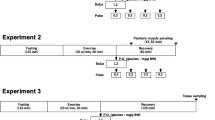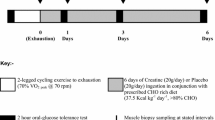Summary
To elucidate the role of muscle glycogen storage on regulation of GLUT4 protein expression and whole-body glucose tolerance, muscle glycogen level was manipulated by exercise and insulin administration. Sixty Sprague-Dawley rats were evenly separated into three groups: control (CON), immediately after exercise (EX0), and 16 h after exercise (EX16). Rats from each group were further divided into two groups: saline- and insulin-injected. The 2-day exercise protocol consisted of 2 bouts of 3-h swimming with 45-min rest for each day, which effectively depleted glycogen in both red gastrocnemius (RG) and plantaris muscles. EX0 rats were sacrificed immediately after the last bout of exercise on second day. CON and EX16 rats were intubated with 1 g/kg glucose solution following exercise and recovery for 16 h before muscle tissue collection. Insulin (0.5 μU/kg) or saline was injected daily at the time when glucose was intubated. Insulin injection elevated muscle glycogen levels substantially in both muscles above saline-injected group at CON and EX16. With previous day insulin injection, EX0 preserved greater amount of postexercise glycogen above their saline-injected control. In the saline-injected rats, EX16 significantly increased GLUT4 protein level above CON, concurrent with muscle glycogen supercompensation. Insulin injection for EX16 rats significantly enhanced muscle glycogen level above their saline-injected control, but the increases in muscle GLUT4 protein and whole-body glucose tolerance were attenuated. In conclusion, the new finding of the study was that glycogen overload by postexercise insulin administration significantly abolished the exercise-induced increases in GLUT4 protein and glucose tolerance.
Similar content being viewed by others
References
16. Romijn JA, Klein S, Coyle EF, Sidossis LS, Wolfe RR. (1993) Strenuous endurance training increases lipolysis and triglyceride-fatty acid cycling at rest. J Appl Physiol 75:108–113
1. Bergstrom J, Hultman E. (1966) Muscle glycogen synthesis after exercise: an enhancing factor localized to the muscle cells in man. Nature 210:309–310
2. Bergstrom J, Hermansen L, Hultman E, Saltin B. (1967) Diet, muscle glycogen and physical performance. Acta Physiol Scand 71:140–150
10. Ivy JL, Zderic TW, Fogt DL (1999) Prevention and treatment of non-insulin-dependent diabetes mellitus. Exerc Sport Sci Rev 27:1–35
13. Marshall BA, Mueckler MM. (1994) Differential effects of GLUT-1 or GLUT-4 overexpression on insulin responsiveness in transgenic mice. Am J Physiol 267:E738–744
12. Kuo CH, Browning KS, Ivy JL. (1999) Regulation of GLUT4 protein expression and glycogen storage after prolonged exercise. Acta Physiol Scand 165:193–201
14. Olson AL, Pessin JE (1996) Structure, function, and regulation of the mammalian facilitative glucose transporter gene family. Annu Rev Nutr 16:235–256
15. Ren JM, Barucci N, Marshall BA, Hansen P, Mueckler MM, Shulman GI. (2000) Transgenic mice overexpressing GLUT-1 protein in muscle exhibit increased muscle glycogenesis after exercise. Am J Physiol 278:E588–592
19. Tsao TS, Li J, Chang KS, Stenbit AE, Galuska D, Anderson JE, Zierath JR, McCarter RJ, Charron MJ. (2001) Metabolic adaptations in skeletal muscle overexpressing GLUT4: effects on muscle and physical activity. FASEB J 15:958–969
11. Kawanaka K, Nolte LA, Han DH, Hansen PA, Holloszy JO. (2000) Mechanisms underlying impaired GLUT-4 translocation in glycogen-supercompensated muscles of exercised rats. Am J Physiol 279:E1311–1318
4. Cheng IS, Lee NY, Liu KL, Liao SF, Huang CH, Kuo CH. (2005) Effect of post-exercise carbohydrate supplementation on glucose uptake-associated gene expression in human skeletal muscle. J Nutr Biochem 16:267–271
20. Yang SC, Chen CY, Liao YH, Lin FC, Lee WC, Cho YM, Chen MC, Chou CH, Kuo CH (2005) Interactive effect of an acute bout of resistance training and DHEA administration on glucose tolerance and serum lipids in middle-aged women. Chin J Physiol 48:23–30
5. Chiu LL, Chou SW, Cho YM, Ho HY, Ivy JL, Hunt D, Wang PS, Kuo CH (2004) Effect of prolonged intermittent hypoxia and exercise training on glucose tolerance and muscle GLUT4 protein expression in rats. J Biomed Sci 11:838–846
17. Srere PA. (1969) Citrate synthase. Methods in Enzymol 230:946–950
8. Fueger PT, Shearer J, Bracy DP, Posey KA, Pencek RR, McGuinness OP, Wasserman DH. (2005) Control of muscle glucose uptake: test of the rate-limiting step paradigm in conscious, unrestrained mice. J Physiol 562:925–935
18. Torgan CE, Brozinick JT Jr, Banks EA, Cortez MY, Wilcox RE, Ivy JL. (1993) Exercise training and clenbuterol reduce insulin resistance of obese Zucker rats. Am J Physiol 264:E373–379
3. Brozinick JT Jr, Etgen GJ Jr, Yaspelkis BB, Ivy JL (1994) The effects of muscle contraction and insulin on glucose-transporter translocation in rat skeletal muscle. Biochem J 297:539–545
6. Etgen GJ Jr, Jensen J, Wilson CM, Hunt DG, Cushman SW, Ivy JL (1997) Exercise training reverses insulin resistance in muscle by enhanced recruitment of GLUT-4 to the cell surface. Am J Physiol 272:E864–869
7. Fell RD, Terblanche SE, Ivy JL, Young JC, Holloszy JO. (1982) Effect of muscle glycogen content on glucose uptake following exercise. J Appl Physiol 52:434–437
9. Garcia-Roves PM, Han DH, Song Z, Jones TE, Hucker KA, Holloszy JO (2003) Prevention of glycogen supercompensation prolongs the increase in muscle GLUT4 after exercise. Am J Physiol 285:E729–736
Acknowledgement
This work was partially supported (Grant # 93-2413-H-154-005) by the National Science Council, Taiwan.
Author information
Authors and Affiliations
Corresponding author
Rights and permissions
About this article
Cite this article
Chou, CH., Tsai, YL., Hou, CW. et al. Glycogen overload by postexercise insulin administration abolished the exercise-induced increase in GLUT4 protein. J Biomed Sci 12, 991–998 (2005). https://doi.org/10.1007/s11373-005-9019-9
Received:
Accepted:
Published:
Issue Date:
DOI: https://doi.org/10.1007/s11373-005-9019-9




